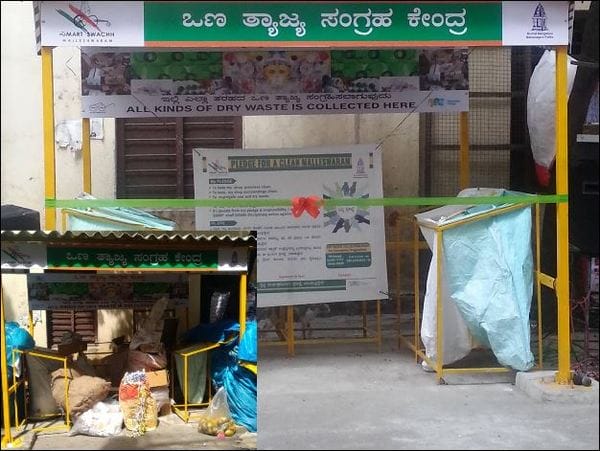With persistence and passion, citizen volunteers supported by progressive BBMP rules, have been working tirelessly and successfully at bringing about a paradigm change in managing waste in their homes and waste reduction. This has been stopping once and for all the nasty careless habit of swinging a plastic carry bag full of mixed waste at the tip of the fingers, walking out to the nearest electric pole or open space and swinging it with a flourish.
However, public waste bins have made a come back in Bengaluru, after a gap of 15 years. These waste drop boxes bypass all of that and encourage people to walk out of their homes swinging the plastic bags and giving it to the person manning the waste boxes. Tch..Tch..Tch.. What a waste…!
The concerns regarding bins
There is a real concern that it will derail the commitment to fixing the door-to-door collection system because waste drop boxes are neither a sustainable solution nor a permanent one. In the interim when they are actively managed and supported by citizen and CSR funding, they may look like a magic wand solution because of the visual cleanliness that they instantly bring in. But the lingering question is what happens when the CSR funding is no more there and citizen involvement wanes.
What can only work and can last long is a waste management at the household level supplemented with a strong municipality mechanism of door-to-door collection.
Reliance on waste boxes will bypass the detailed requirements and preparation of the door-to-door collection arrangements that have been ongoing for the last many years. To ensure smooth door-to-door collection and transportation from start to finish, every segment has been getting identified and painstakingly detailed by citizen groups working with the BBMP either bringing in policy change, process change through Court interventions and dialogue. When we are now in the last mile of implementation stage with imminent restructuring of the door-to-door collection system, this tangential effort of setting up expensive primary collection waste drop boxes is both distressing and frustrating.
Who is worried about money?
The current efforts are aimed at setting three areas right.
| Segment 1 – SAS ……..> |
Segment 2 – C&T ………> |
Segment – 3 |
| Segregation At Source | Collection & Transportation | Destination |
There is an allocation for supporting the door-to-door collection. This money is being paid out to contractors on a monthly basis. Is the BBMP cutting back on these payments for the areas where waste boxes are installed? If they are still being paid out, who is receiving this money and why!
It may be justified that the CSR funding is taking care of installation of waste boxes. If the government now decides to adopt waste boxes, why is this investment being done before rectifying the door-to-door collection and without the same investment going first towards fixing the door-to-door collection vehicles and upgrading the dry waste collection centres meant for the purpose of receiving dry waste?
Alternatives to the bin system
When bins were removed from Bengaluru way back in the year 2000, it was for a reason. Installing the waste boxes has been mainly justified as a necessary intervention for removing black spots and providing visual cleanliness. Now let’s look at the other possible solutions.
Scenario 1:
Residential area: Those residents who drop off at the black spot now drop off at the waste boxes in the same location.
Identifying the Problem
These are residents who either do not synchronise their handing over with the collection auto and have a place to go drop off their waste at their convenience
- It is the responsibility of the Auto collector to report those who do not hand over their waste. It is the responsibility of the resident to speak to the auto collector and work out a place and a system of handover.
- Wherever the door to door collection auto is not available at all or is not visiting door to door . The Door to door collection mechanism needs to be compulsorily activated.
Scenario 2:
Poura Karmikas who dump garbage on the ground now drop off their waste into the waste bins. The PKs need to be directed and trained on Vehicle-to-Vehicle transfer which works very well in reducing secondary black spots. The ideal solution is to replace luggage autos and pushcarts immediately with auto tippers.
Scenario 3:
Commercial area: Waste drop boxes serve as drop off bins which serve as both litter bins as well as drop off points right through the day.
Dry waste dropped off by shops packed for dispatch to DWCC in the recently inaugurated dry waste Kiosk in Malleshwaram. Pic: Sandya Narayan
A highly dense commercial market area is the only area where a manned kiosk is recommended and justified for providing a drop off facility right through the day.
Malleshwaram set up such kiosks recently, between 8th and 9th cross, behind Raghavendra Swamy Mutt. This kiosk is manned right through the day in two shifts — first shift by BBMP and the second funded by the Traders Association who benefit from it.
The setting up and running costs for this system are a fraction of the waste drop boxes and more importantly the dry waste is sorted and stored and ready to be given to the local DWCC. The person manning the kiosk has an incentive in managing the kiosk effectively. Remaining waste in the area is mostly wet, which is easy to dispose by composting or biomethanation.
Related Articles
Goons encroach BBMP land, shut dry waste collection centre
From waste wise projects to dry waste centers, story of trash in Bengaluru
Here’s how Dry Waste Collection Centres started functioning in Bengaluru
